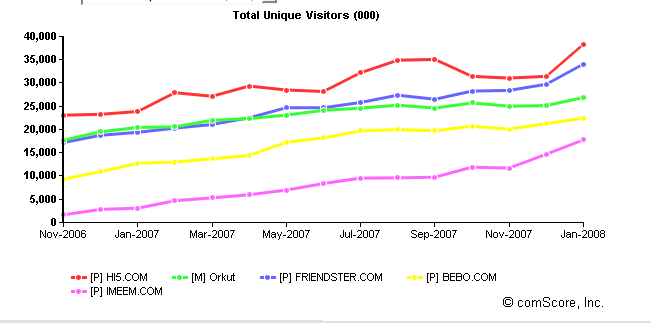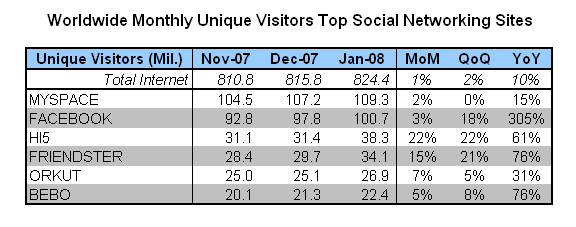 In the global race to be the top social network, MySpace and Facebook are neck and neck. In January, 2008, MySpace was still the biggest social network worldwide with 109 million unique visitors, according to comScore. But Facebook was close on its heels with 101 million. (Meanwhile, the data in the U.S. for Facebook at least shows a possible slowdown in growth).
In the global race to be the top social network, MySpace and Facebook are neck and neck. In January, 2008, MySpace was still the biggest social network worldwide with 109 million unique visitors, according to comScore. But Facebook was close on its heels with 101 million. (Meanwhile, the data in the U.S. for Facebook at least shows a possible slowdown in growth).
While MySpace and Facebook are fighting it out for the top spot, back in the second pack some interesting sprints and scuffles are going on that are worth keeping an eye on. Everyone in that second pack (Hi5, Freindster, Orkut, Bebo, Imeem) are about a third to a quarter the size of the leaders in terms of worldwide unique visitors, so I’ve isolated their performance in the chart above (it is harder to see if you include Nos. 1 and 2, MySpace and Facebook).
In January, both Hi5 (No. 3, in red) and Friendster (No. 4, in blue), made moves to pull away from Google’s Orkut (No. 5, in green) and Bebo (No. 6, in yellow). The latter two maintained a more steady pace. Coming on strong from behind is Imeem (No. 7, in purple), which surpassed Multiply (No. 8, not shown). The chart below has most of the stats, except for the last two—Imeem had 17.8 million global visitors in January, 2008, a 477 percent annual growth rate (Multiply had 17.6 million, a healthy 203 percent rise from the year before).
For Hi5 and Friendster, global growth is a major part of their game plan. Friendster, for instance, which dropped off the radar for most of us in the U.S., is now the single largest social network in Asia. It’s top five countries are the Philippines, Indonesia, Malaysia, the United States (legacy members who never left, plus new growth among Asians here), and Singapore. Friendster has kept its growth going by launching fan profile pages for Asian pop singers, launching four new languages since September (Chinese, Japanese, Korean, and Spanish), and letting developers create apps for its site.
So does that mean that Friendster and Hi5 are worth more than the $1 billion Bebo is rumored to have sold itself for? Not necessarily. It depends on the actual composition of their members, click-through rates, and other financial factors. Generally speaking, advertisers like to target their campaigns by geography, and pay less for ads that target populations with lower per-capita spending power than in the U.S., Japan, or Europe. So not all members are worth the same to advertisers, and thus to potential acquirers. But as social networks become saturated here in the U.S., everyone will have to look overseas to keep growing.
